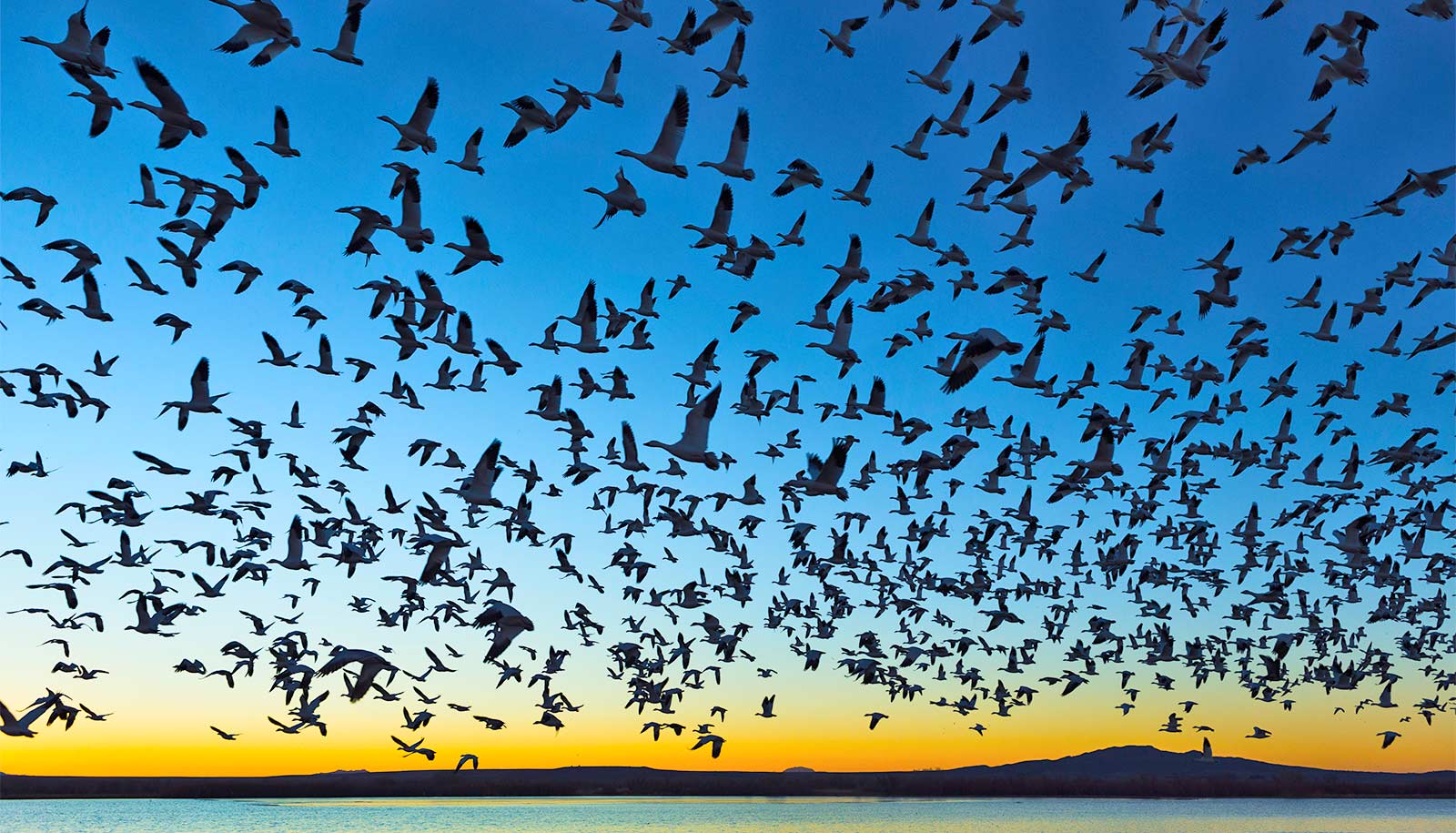Space weather disrupts nocturnal bird migration, a new study finds.
It’s well-known that birds and other animals rely on Earth’s magnetic field for long-distance navigation during seasonal migrations.
But how do periodic disruptions of the planet’s magnetic field, caused by solar flares and other energetic outbursts, affect the reliability of those biological navigation systems?
Researchers used massive, long-term datasets from networks of US Doppler weather radar stations and ground-based magnetometers—devices that measure the intensity of local magnetic fields—to test for a possible link between geomagnetic disturbances and disruptions to nocturnal bird migration.
They found a 9%-17% reduction in the number of migrating birds, in both spring and fall, during severe space weather events. And the birds that chose to migrate during such events seemed to experience more difficulty navigating, especially under overcast conditions in autumn.
The new findings, published in the Proceedings of the National Academy of Sciences, provide correlational evidence for previously unknown relationships between nocturnal bird migration dynamics and geomagnetic disturbances, the researchers say.
“Our findings highlight how animal decisions are dependent on environmental conditions—including those that we as humans cannot perceive, such as geomagnetic disturbances—and that these behaviors influence population-level patterns of animal movement,” says lead author Eric Gulson-Castillo, a doctoral student in the University of Michigan ecology and evolutionary biology department.
Earth’s magnetic field is regularly affected by solar outbursts that can trigger colorful auroras and that sometimes disrupt satellite communications, human navigation systems, and power grids.
But little is known about how those disturbances affect animals that depend on Earth’s magnetic field for migratory orientation and navigation. Previous experimental studies over several decades provide strong evidence that birds, sea turtles, and other organisms key into small changes in magnetic inclination, intensity, and declination when making orientation decisions and developing navigational maps.
One recent study examined millions of bird banding records and found that geomagnetic disturbances were associated with increased incidence of migratory bird “vagrancy,” that is, birds becoming lost during migration.
But most previous studies were narrowly focused in geographic extent, duration, and the number of species examined. The newly published study, in contrast, uses a 23-year dataset of bird migration across the US Great Plains to provide new insights at population and landscape levels.
The researchers used images collected at 37 NEXRAD radar stations in the central flyway of the US Great Plains, a major migratory corridor. The flyway spans more than 1,000 miles in the US, from Texas to North Dakota.
The research team selected this relatively flat region to minimize influences from mountainous topography or oceanic and Great Lakes coastlines. Their final datasets included 1.7 million radar scans from the fall and 1.4 million from the spring.
The community of nocturnally migrating birds in this region is primarily composed of a diverse set of perching birds (Passeriformes, 73% of species) such as thrushes and warblers; shorebirds (Charadriiformes, 12%) such as sandpipers and plovers; and waterfowl (Anseriformes, 9%) such as ducks, geese, and swans.
The NEXRAD radar scans detect groups of hundreds to thousands of migrating birds. Migration intensity—meaning the number of birds in each cluster—can be estimated and direction of flight can be measured.
Concurrent geomagnetic measurements were accessed through superMAG, a worldwide collection of geomagnetic ground stations. Data were collected from magnetometer stations near weather radar sites.
The researchers matched data from each radar station with a customized, spatiotemporally explicit index of geomagnetic disturbance that represents the maximum hourly change from background magnetic conditions.
Daniel Welling, assistant professor in the climate and space sciences and engineering department at the University of Michigan and Michelle Bui, a former University of Texas at Arlington undergraduate, compiled the space weather data and designed the geomagnetic disturbance index. Welling and Bui are coauthors of the new study.
“The biggest challenge was trying to distill such a large dataset—years and years of ground magnetic field observations—into a geomagnetic disturbance index for each radar site,” Welling says. “There was a lot of heavy lifting in terms of assessing data quality and validating our final data product to ensure that it was appropriate for this study.”
The data trove was fed into two complementary statistical models to measure the putative effects of magnetic disturbances on bird migration. The models controlled for the known effects of weather, temporal variables such as time of night, and geographic variables such as longitude and latitude.
“We found broad support that migration intensity decreases under high geomagnetic disturbance,” says senior author Ben Winger, assistant professor in the ecology and evolutionary biology department and a curator of birds at the University of Michigan Museum of Zoology.
“Our results provide ecological context for decades of research on the mechanisms of animal magnetoreception by demonstrating community-wide impacts of space weather on migration dynamics.”
The researchers also found that migrating birds appear to drift with the wind more frequently during geomagnetic disturbances in the fall, instead of expending great effort to battle crosswinds.
“Effort flying” against the wind was reduced by 25% under cloudy skies during strong solar storms in the fall, suggesting that a combination of obscured celestial cues and magnetic disruption may hinder navigation.
“Our results suggest that fewer birds migrate during strong geomagnetic disturbances and that migrating birds may experience more difficulty navigating, especially under overcast conditions in autumn,” says Gulson-Castillo, who conducted the study as part of his doctoral dissertation. “As a result, they may spend less effort actively navigating in flight and consequently fly in greater alignment with the wind.”
Additional coauthors are from Cornell University, Colorado State University, and the University of Michigan.
The National Science Foundation supported the work.
Source: University of Michigan
Author Profile
- "Center" Bias Rating
- Futurity is a nonprofit website that aggregates news articles about scientific research conducted at prominent universities in the United States, the United Kingdom, Canada, Europe, Asia, and Australia. It is hosted and edited by the University of Rochester.





